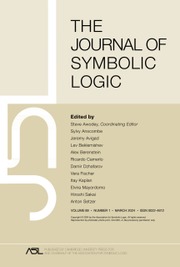Article contents
THE ADDITIVE GROUPS OF  $\mathbb {Z}$ AND
$\mathbb {Z}$ AND  $\mathbb {Q}$ WITH PREDICATES FOR BEING SQUARE-FREE
$\mathbb {Q}$ WITH PREDICATES FOR BEING SQUARE-FREE
Published online by Cambridge University Press: 05 October 2020
Abstract
We consider the structures  $(\mathbb {Z}; \mathrm {SF}^{\mathbb {Z}})$,
$(\mathbb {Z}; \mathrm {SF}^{\mathbb {Z}})$,  $(\mathbb {Z}; <, \mathrm {SF}^{\mathbb {Z}})$,
$(\mathbb {Z}; <, \mathrm {SF}^{\mathbb {Z}})$,  $(\mathbb {Q}; \mathrm {SF}^{\mathbb {Q}})$, and
$(\mathbb {Q}; \mathrm {SF}^{\mathbb {Q}})$, and  $(\mathbb {Q}; <, \mathrm {SF}^{\mathbb {Q}})$ where
$(\mathbb {Q}; <, \mathrm {SF}^{\mathbb {Q}})$ where  $\mathbb {Z}$ is the additive group of integers,
$\mathbb {Z}$ is the additive group of integers,  $\mathrm {SF}^{\mathbb {Z}}$ is the set of
$\mathrm {SF}^{\mathbb {Z}}$ is the set of  $a \in \mathbb {Z}$ such that
$a \in \mathbb {Z}$ such that  $v_{p}(a) < 2$ for every prime p and corresponding p-adic valuation
$v_{p}(a) < 2$ for every prime p and corresponding p-adic valuation  $v_{p}$,
$v_{p}$,  $\mathbb {Q}$ and
$\mathbb {Q}$ and  $\mathrm {SF}^{\mathbb {Q}}$ are defined likewise for rational numbers, and
$\mathrm {SF}^{\mathbb {Q}}$ are defined likewise for rational numbers, and  $<$ denotes the natural ordering on each of these domains. We prove that the second structure is model-theoretically wild while the other three structures are model-theoretically tame. Moreover, all these results can be seen as examples where number-theoretic randomness yields model-theoretic consequences.
$<$ denotes the natural ordering on each of these domains. We prove that the second structure is model-theoretically wild while the other three structures are model-theoretically tame. Moreover, all these results can be seen as examples where number-theoretic randomness yields model-theoretic consequences.
Information
- Type
- Article
- Information
- Copyright
- © Association for Symbolic Logic 2020
References
- 1
- Cited by


